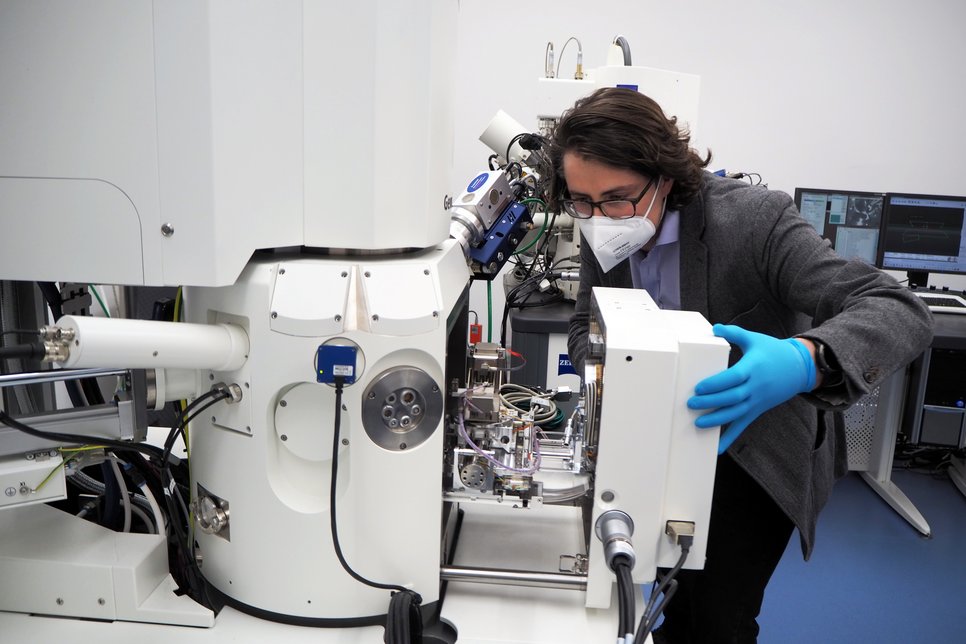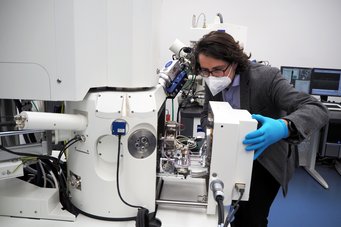Australia to Switzerland and now Germany at the MPIE
From the global to the nano-scale
Since April 2020, Dr. James Best heads the group “Nano-/Micromechanics of Materials“ and is interim leader of the group “Thin Films and Nanostructured Materials”, both in the “Structure and Nano-/Micromechanics of Materials” department at the MPIE.
Yasmin Ahmed Salem (YAS): Nano- and Micromechanics – why do you focus on these length scales?
James Best (JB): I find it fascinating to accurately probe and manipulate materials at dimensions not visible to our eyes. Materials at different length-scales behave differently – below some 10’s of micrometres the properties are not only determined by alloy composition and structure, but also by the sample size itself where defects play a much bigger role. My group aims at unravelling connections between fundamental deformation mechanisms, material structure, and the local chemistry at defect sites.
YAS: Do you have certain alloy systems in mind?
JB: I do not focus my research on specific alloy systems but target broader fundamental questions such as, for example, how grain boundary structure and chemistry is linked to the functional properties of materials like strength or toughness. Such questions can be incredibly important in our world; from developing mechanically stable battery systems for industrial storage applications, to designing energy efficient reduction routes using hydrogen instead of carbon by understanding the high-temperature fracture of iron ores. It can often be overlooked that the material deformation and failure of large industrial systems generally begin at the micro- and nanometre length-scales. That was an insight strengthened during my Postdoc at EMPA. In this time, I was involved in the European project “ToughTools” to design long-life industrial steel forging dies.

YAS: This sounds like a vast dimension of possible research projects. Which devices do you use for your research?
JB: My group focusses on performing controlled nanomechanical tests in-situ, which predominately means for us within scanning electron microscopes. This allows us to “see” what happens in real-time as we deform specially designed geometries of material. We can observe plasticity transmission or crack growth, for example, and directly relate these observations back to mechanical data and theory. Our results are then combined with the results of our MPIE colleagues who use transmission electron microscopy and atom probe tomography to gain insight into the chemistry of the samples.
YAS: I guess, possible applications are mainly in the electronics field, like microchips of mobile phones and similar devices. Which other applications do you aim at?
JB: Along with applications of thin-film systems in electronics or as protective coatings, we also focus on structural materials such as the lightweight microstructural design of steels and magnesium alloys, along with the additive manufacturing of advanced alloy systems such as metallic glasses. Applications range from high-temperature materials for fusion reactors to low-temperature materials for space exploration… and many in between!
YAS: After being at different countries and research institutions, what would you say is special about working at the MPIE?
JB: The people, definitely. People here are so enthusiastic about their research. The whole environment stimulates the discussion of new approaches, especially as the different groups and departments work closely together, and there are no limits for scientific ideas. That’s one big plus of working here for sure.
Dr. James Best studied Chemistry and Chemical Engineering at the University of Melbourne (Australia) where he also completed his PhD in 2013, before a 4 year Postdoc at the Swiss Federal Laboratories for Materials Science and Technology (EMPA). He thereafter held a Senior Research Associate position in the School of Mechanical and Manufacturing Engineering at the University of New South Wales (Australia), which included a secondment to the RWTH Aachen University (Germany) in 2019, before joining the MPIE in 2020.
